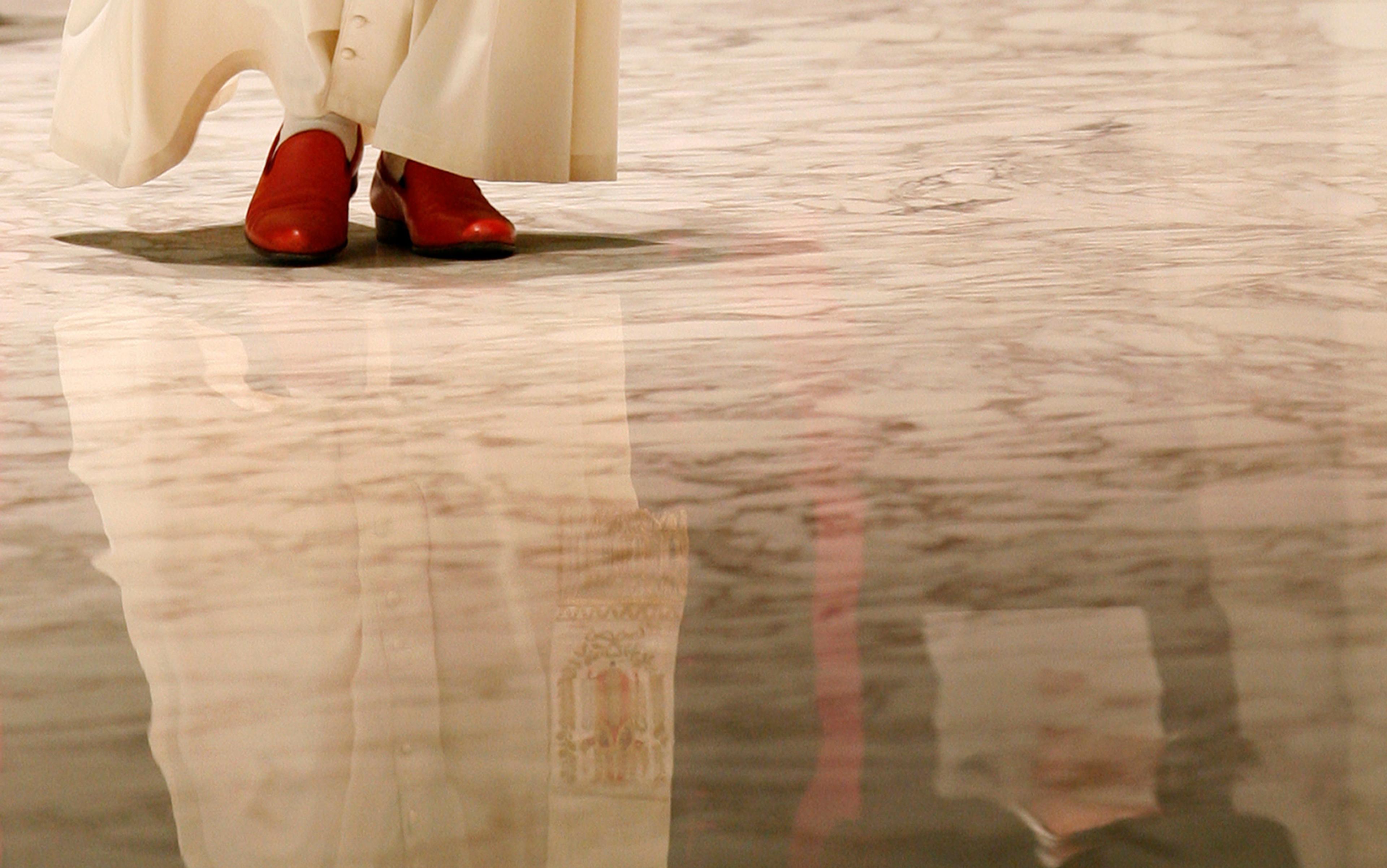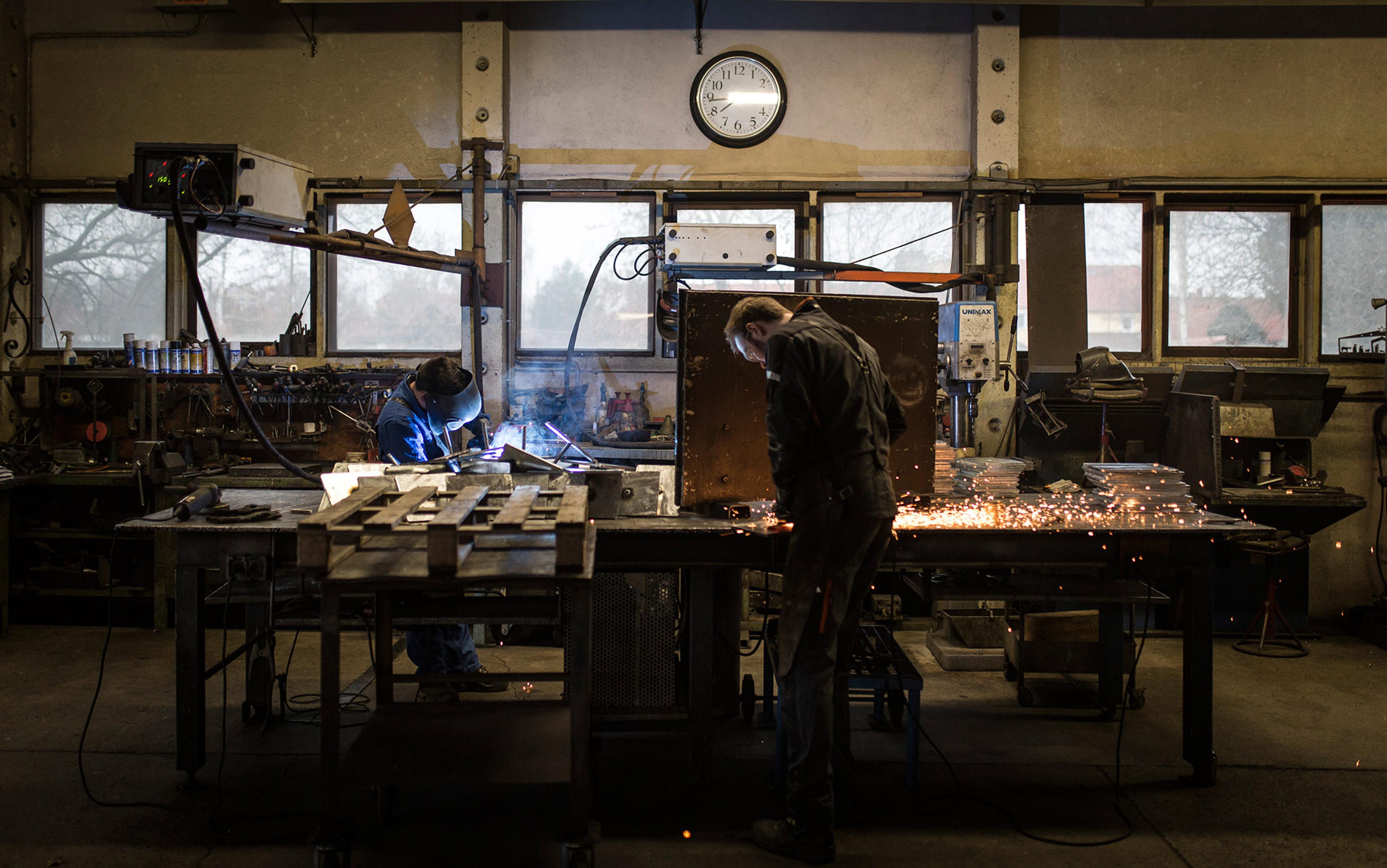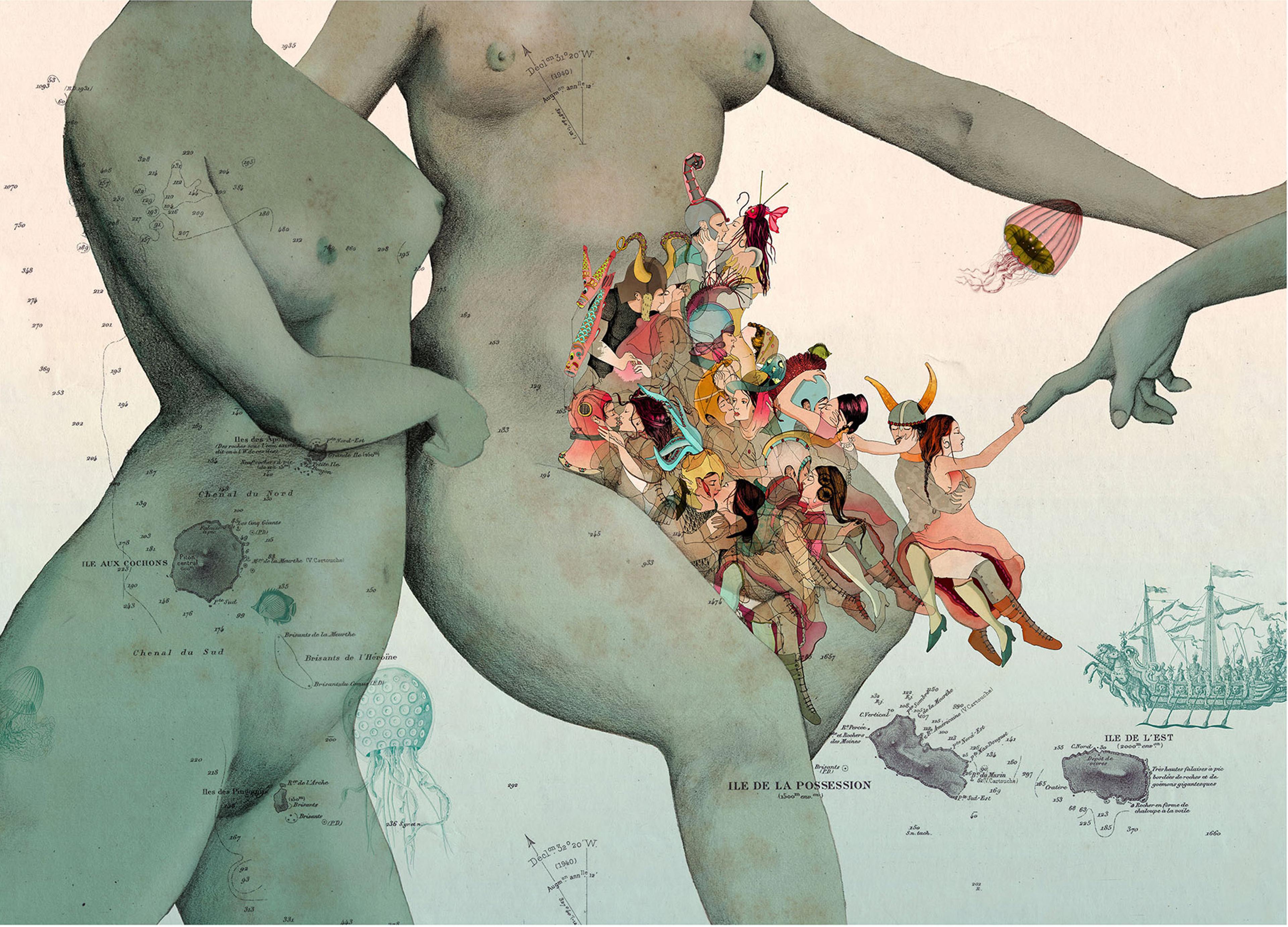Consider this pair of shoes from early 18th-century Britain. Are they a man’s or a woman’s? This question is trickier than it might appear. The shoe has a high heel, which today we associate with feminine footwear. By contrast, men’s footwear nowadays tends to have a low heel, and be sturdy and practical – an example of stereotypically masculine footwear might be a heavy work boot.

Silk brocade shoes, c1730. Image courtesy of Northampton Museum and Art Gallery
There is, however, nothing ‘natural’ about men’s and women’s footwear styles. It is not primarily about anatomy. There are differences between men’s and women’s feet – men’s feet aren’t just scaled-up versions of women’s, since there are small but significant differences in their shape and width – but it would be perfectly possible to produce visually similar shoes for men and women. The reasons why we tend not to do this are instead due to culture and social roles.
Footwear tells us a lot about the history of men and women, and expectations of how they were supposed to behave. The reason why shoes are so socially important is because of their close relationship with our bodies. To understand shoes, we need to think about them as worn objects: material articles that interact with the bodies that wear them. This sounds like an obvious thing to say, but it is important. Shoes support our entire bodies, so they affect how we stand, how we move, and what sorts of surfaces we can move upon. This, in turn, enables the wearer to do certain things, and prevents them from doing others. Choices of footwear therefore say a lot about someone’s job, the spaces they are expected to occupy, and the role they have in society.
This is partly about style. The ‘look’ of a shoe is important, as it marks our appearance, the image that we want to project and how we see ourselves. A stiletto heel, for instance, has potent meanings for us today, suggesting femininity, sexuality and power. But it is also practically suited to certain locales and tasks: it would be out of place on a building site, in the same way as a steel-toecap boot would be out of place on a catwalk. It furthermore affects how the body moves in a very direct way. The podiatrist William Rossi argued in The Sex Life of the Foot and Shoe (1976) that high heels increase the motion of the hips while walking, and shape the posture in a sexually provocative way, accentuating the calves, buttocks and chest.
A heavy work boot, on the other hand, gives the wearer a very different gait. It provides grip, enabling them to walk on rough surfaces, while protecting the foot against injury and the ingress of liquid or foreign objects. In this way, it facilitates the performance of manual labour in outdoor locations.
It is therefore the physical properties of footwear that ultimately define the social role of their wearer.
With this in mind, let us return to our pair of early 18th-century shoes, and the question of whether they were worn by a man or a woman. In this period, shoes for elite men and women were very similar. Both sexes might wear colourful shoes decorated with patterned fabrics. They did not have to protect against the elements since people from the upper classes were not expected to walk any great distance. They would instead be conveyed by sedan chair or carriage, or could wear ‘pattens’ that would elevate their precious shoes above the mud. The very impracticality of their footwear indicated their status.
Furthermore, shoes for elite persons of both sexes would often have a high heel. They were made differently – men’s heels were constructed of stacked pieces of leather, whereas women’s more shapely heels might be carved from wood – but they looked similar. Either could be covered with fabric or leather, so it can be difficult to tell how they were constructed, and therefore which sex they were made for. In the early modern world, the high heel was a marker of class status rather than gender as such. Men of the aristocracy wore heels to accentuate their height and impressive bearing, at a time when the upper classes literally towered over their inferiors due to better nutrition and deportment. At the court of Louis XIV, courtiers wore red heels – les talons rouge – to symbolise the might of the Sun King and the nobility. Heels were also associated with horse riding, since you needed a high heel to keep the foot in the stirrups, and equestrianism was linked to high rank in the military and society.

Those heels. Portrait of Louis XIV (1700s) after Hyacinthe Rigaud. Courtesy the J Paul Getty Museum
As such, the shoe in the image above is a man’s shoe, but you’d be forgiven for thinking that it was a woman’s, given how alike they could be. This highlights that, where the history of footwear is concerned, it is vitally important to place shoes in their proper context, thinking about how the social role of their wearers relates to the physical properties of the artefact and the effect it has on their bodies. And if the social context changes, then so do shoes.
Fashionable women’s shoes wore out so quickly that women were known to buy several pairs at a time
If men and women wore similar shoe styles at the beginning of the 18th century, this changed as the century wore on. As I explore in my book Shoes and the Georgian Man (2025), men’s shoes generally became plainer in colour, mostly being made from black leather. Fine shoes could have shiny uppers and exquisite workmanship, and decorative buckles became larger and more elaborate until they fell from favour altogether in the 1790s. But, in general, they become monochrome and more suitable for walking. Heels lowered, and even boots – which had formerly been worn only for riding – became more supple and practical. By the time of the Regency, Englishmen were wearing fine leather boots, which could be worn for both riding and walking, and were fashionable in town and country. Such footwear befitted the statesman or businessman, and enabled easy mobility in the public world that he was expected to dominate. They also showed off the contours of his leg, grounding his status in the refinement of his masculine body.

Fine Regency-era boots. Joseph-Antoine de Nogent (1815) by Jean-Auguste-Dominique Ingres. Courtesy Harvard Art Museums
By contrast, women’s shoes became flimsier. Whereas men’s shoes were almost invariably made from leather, fashionable women increasingly wore shoes made from textiles such as cotton, wool or silk. By the early 19th century, fashionable women’s shoes wore out so quickly that women were known to buy several pairs at a time. Such shoes were only really suited for indoor wear: they were ideal for dancing and indoor social functions, but would be quickly spoiled by a trip outside.
Historians often argue that gender roles diverged over the course of the 18th century. Whereas the early modern world had a more flexible understanding of gender difference, these ideas hardened and polarised over the course of the Georgian period. Men and women apparently had different biologies, physiques and psychological natures, which equipped them for different social roles. Half a century ago, women’s historians argued that the period saw the emergence of ‘separate spheres’, whereby men came to dominate the public worlds of politics and work, while women were confined to the private world of homemaking and childrearing. This provided a structural explanation for the emergence of patriarchy and gender inequality in the modern world. The ‘separate spheres’ interpretation is less fashionable nowadays, as historians tend to study culture rather than social structures.
However we tell the story, shoes were part of a significant realignment of sexual relations. They did not so much reflect the changes as help to drive them. If ideas about gender were changing in this period, shoes were an agent by which these ideas were grounded in everyday practice. Shoe design was influenced by developments in wider fields – such as politics, science and the visual arts – and focused these developments on objects that practically impacted the lives of their wearers. They physically dictated the kinds of spaces that men and women could occupy, and the roles that they could perform within them. If the 18th century created modern gender relations, it was partly because of what Georgians were wearing on their feet.
If shoes have historically served to categorise groups of people, they also say a lot about us as individuals. As a commentator noted in 1825: ‘Religion, patriotism, public and private virtue, pure and fixed principles of taste, intellectual and corporeal refinement, all – all depend upon the choice of shoes.’
This is because shoes have a very close relationship with their wearer. Because they support the weight and motions of the body, they are put under considerable stress, and have to be made in such a way so as to withstand it. This means that they have to be made from particular materials, which on the one hand are comfortable and pliable, but on the other are hardwearing and waterproof. For centuries, the only material that ticked all the boxes was leather. Leather comes from animal skin, so when we wear it on our bodies it becomes a kind of second skin. As the foot rubs on the shoe, hardening its own skin and softening the leather, it is difficult to draw the line between where the body ends and the shoe begins.
As we exert weight and pressure on the shoe, it moulds to our foot and our way of walking. The shoe takes on the shape of our foot and becomes more comfortable and flexible. Our shoes ‘wear in’ until they eventually ‘wear out’: the sweet spot for comfortable footwear is somewhere in the middle. A heavily worn shoe may not look very presentable, but it is likely more comfortable than a new one, so it is no wonder that we become attached to them.
We get ghostly traces of a former owner: the shoe provides a ‘primary source’ for their wearer
The way that shoes wear is unique to the wearer. You can’t really do it for somebody else as they mould specifically to your foot, so most people wear in their shoes while doing other tasks, though the royals apparently have a different way of doing things. The late Queen Elizabeth II had an aide wear in her shoes, Angela Kelly, who reported that ‘the Queen has very little time to herself and no time to wear in her own shoes.’ Presumably, their feet were of a very similar size and shape, and even this would have been a compromise, since the shoes would have worn in differently once the Queen herself started to walk in them.
If you look at a worn shoe, you can see the outline of the wearer’s foot. Because we sweat, bleed and shed skin in our shoes, sometimes bodily material from the wearer is visible in the shoe. Furthermore, by looking at the wear to the soles and stretches or damage to the uppers, we can see a record of the wearer’s walking gait. By examining dirt and scuffs on the leather, we can think about what the wearer did in the shoe, perhaps their occupation or the terrain on which they walked. By examining repairs and adaptations to the shoe, or the extent to which they have been polished and cared for, we can speculate about the economic means of the wearer. We therefore get ghostly traces of their former owner: the shoe provides what historians call a ‘primary source’ for their wearer. No other garment captures the wearer’s body in this way, nor impacts the movements of that body in such a direct way. Shoes give us an insight into how bodies moved in the past, something that is otherwise very difficult to study.
For this reason, worn historic shoes are more interesting than pristine ones. They are one category of museum artefact where curators prefer imperfect examples, and tend not to mend or restore them. It is better to put a dilapidated shoe on display than a new one, since it has more stories to tell. A new shoe might be pleasant to look at, but ultimately it tells you only about the object itself, whereas the dilapidated shoe tells us about the life of a historic human being.
For example, the shoe below was discovered by builders at the Historic Dockyard in Chatham, during renovations to the Rigging House. It is recognisably of an 18th-century style, being ‘straight lasted’ rather than shaped for the left or right foot, so it is symmetrical and could be worn on either foot. It is in fairly poor condition, suggesting that it was heavily worn. It’s a shoe of fairly basic construction, so would likely not have been worn by a member of the elite. Its shape is fairly broad, and the wearer has cut slits in the vamp to create more room. It is therefore likely that they experienced swelling in their foot, probably caused by gout, which was very common in the 18th century. This shoe is therefore a very rare surviving example of a gout shoe (or ‘great shoe’), an assistive object that helped the wearer to mitigate a painful foot condition. It would have provided relief to the swollen limb, and would have enabled a modicum of mobility, since gout had a very restrictive effect on the lives of its sufferers. This battered old shoe therefore helps us to think about the history of disability.

Gout shoe, 18th century © Chatham Historic Dockyard
The connection between the shoe and the wearer goes deeper. Perhaps because shoes mould to our form in a unique way, they have historically been identified with their owner: if you ‘step into another man’s shoes’, you put yourself in his place. The shoe has even been held to retain something of the soul of its owner.
In 18th-century Britain, it was common to conceal worn shoes in the house for good luck and to repel evil spirits. A worn shoe could be placed under a floorboard or in a wall, usually near thresholds such as doors, windows or chimneys. This warded off witches and evil spirits, which would detect the soul of the former owner and either stay away or mistakenly head for the shoe itself. Around the 1950s, Northampton Museum (which houses the UK’s national shoe collection) started to collect these concealed shoes from people who kept discovering them while renovating their houses. Occasionally, the museum didn’t hold on to these shoes for long. Some people, having experienced a subsequent misfortune, promptly asked for the shoe back, in order for it to be returned to its rightful place. But, happily, most didn’t, and the museum now has an index of thousands of concealed shoes – plus many examples of plebeian shoes that otherwise would not have been preserved.
Shoes tell stories about people and their lives, and they often have stories to tell of their own
Shoes can stand in for their wearers in other ways too. A pair of shoes hanging from a telegraph wire can signify that it is a gang’s turf, or perhaps commemorate someone who has passed away. An empty pair of shoes signifies an absence. Some of the most powerful images of the Holocaust are the piles of empty shoes, each one signifying a human being who suffered the horrors of the camps. The image is particularly redolent because of the close connection between shoes and mourning in Judaism. The ancient Israelites did not wear shoes while sitting shiva, the period of mourning that follows the death of a close relative. Many observant Jews today do not wear leather shoes during this period, or they place a pebble in their shoe to remind themselves that they are mourning.

The red shoe of Auschwitz. Courtesy Wikimedia
Shoes tell stories. They tell us about people and their lives, and they often have stories to tell of their own. Shoes can be keepsakes. They may be a reminder of a special event like a wedding or christening. They may have been on an adventure, like an expedition or a marathon. They may have been bought for a special reason, or they may be a perfectly ordinary pair of shoes that happen to remind us of a particular period in our lives. Shoe museums today often display a pair of shoes with an image of their owner and the story that the owner attaches to them.
One of my favourite items of footwear is the pair of brogue boots below, by Tricker’s, which were made in their factory in Northampton. Northampton was the centre of the British shoe industry during the Industrial Revolution, with many factories of famous companies there, to this day, producing expensive handmade shoes. Having lived in the town for some years, I really wanted a pair of Northampton shoes, but I couldn’t afford the usual prices (upwards of £500). Locals know that you can get them at a hefty discount from the factory shops, so I went along to Tricker’s when they were holding a sample sale offering one-off samples and ends-of-line.

Tricker’s ‘Stowe’ brogue country boot. Author’s own
Going to the sample sale was a fascinating experience. You could see into the factory from the shop where the shoemakers were at work. Given that handmade shoemaking has not changed a huge amount since the mid-19th century, it was like walking back in time. Lots of local people were at the sale so it felt like a community event. Northamptonians know where to get good shoes cheaply, so they’re often well shod. Shoemakers from the factory had brought their sons along to get them a smart pair, and discussed how they could change the type of sole for them if they preferred, passing on their knowledge to the next generation.
I was excited to buy these boots and I’m still fond of them. I love that they were one-offs, that they were a bargain, and that they were handmade in a historic local industry. I love that they connect me to my hometown. Like all substantial leather boots, they took a while to wear in, but the fact that I had to work at it means that I am more invested in them. Now they are very comfortable, having moulded to the shape of my feet, and they will probably last a lifetime (give or take a pair of new soles).
Shoes, then, say a great deal about us. It is partly about style and the image that we want to project: they are an important part of how we present ourselves to the world. They can contribute to our self-identity, and to our sense of belonging to a group: a pair of Dr Martens or a particular brand of sneaker can proclaim our membership of a ‘tribe’. Our connection to shoes can therefore be emotional: they relate to our lives, our memories, our sense of place. But we need to explore the physical connection that we have with our shoes if we are really going to understand their significance. Shoes are entangled with our bodies. They affect how our bodies move and the sorts of things that our bodies are able to do. And they mould in a unique way to our bodies, quickly becoming individual to us. It is for this reason that they retain the personality, even the spirit, of their wearer.






